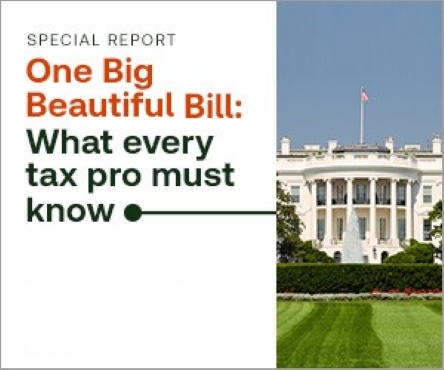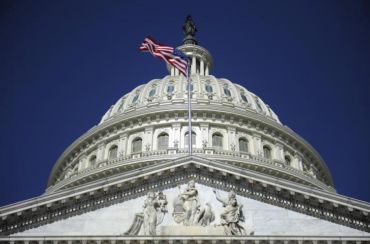Changes to the SALT cap, the effects of the cap on state budgets, and more.
The state and local tax (SALT) deduction has long been a pillar of the U.S. tax code, providing critical relief to taxpayers — especially those in high-tax states. That changed dramatically with the 2017 Tax Cuts and Jobs Act (TCJA), which imposed a $10,000 cap on SALT deductions. Now, with the passage of the One Big Beautiful Bill Act (OBBBA) in July 2025, the landscape is shifting again. This article explores the permanent SALT cap changes enacted under OBBBA, the ongoing impact on state revenues, and what tax professionals need to know going forward.
Jump to ↓
What has changed: The new permanent SALT cap structure
How the SALT cap continues to affect state budgets
What tax professionals need to know about OBBBA’s SALT provisions
How to stay up-to-date with SALT deduction legislation
What has changed: The new permanent SALT cap structure
The OBBBA made permanent modifications to the SALT deduction cap, ending years of temporary rules and political uncertainty. Key provisions of the finalized legislation include:
- A permanent increase in the SALT cap from $10,000 to $40,000.
- A phase-out of the $40,000 cap beginning at Modified Adjusted Gross Income (MAGI) of $250,000 (single filers) and $500,000 (joint filers).
- The deduction phases down at a rate of 30% above these thresholds, until it returns to the original $10,000 cap for the highest earners.
The new cap structure aims to provide more equitable tax relief for middle- and upper-middle-income earners in high-tax states while limiting benefits for top earners.
This resolution ends years of negotiations between the House and Senate, who had previously disagreed on whether the cap should be expanded or maintained. The compromise reflects both revenue concerns and growing pressure from constituents in states like California, New York, and New Jersey.
How the SALT cap continues to affect state budgets
Despite the increased cap, the SALT deduction remains a contentious issue in state fiscal policy. Here’s why:
1. Disposable income and consumer spending
By raising the SALT cap, more taxpayers will see increased federal tax savings, which could boost disposable income and potentially stimulate local economies. This could lead to modest increases in sales tax revenue and consumer activity, particularly in high-tax states.
2. Revenue planning uncertainty
States that previously adjusted their budgets to account for the SALT cap’s revenue impact—either by cutting spending or shifting to other tax sources—will now need to recalibrate. States that rely heavily on income and property taxes may need to reassess their long-term revenue projections.
3. Pass-through entity taxes still relevant
Many states introduced pass-through entity tax (PTET) workarounds to mitigate the effects of the federal SALT cap. These allow pass-through businesses (like partnerships and S corporations) to pay state tax at the entity level and claim a deduction federally. With a higher SALT cap in place, the relative benefit of these PTET elections may decline for some taxpayers—but they will remain a viable strategy, especially for those whose income exceeds the new MAGI thresholds.

The Act of 2025
Keep your firm ahead of the curve. Our 55-page special report provides the authoritative analysis you need.
Get the report ↗What tax professionals need to know about OBBBA’s SALT provisions
The enactment of OBBBA’s SALT provisions doesn’t simplify tax planning—it just reshapes it. Consider these points:
- Clients near the MAGI thresholds ($250K/$500K) will need guidance on how the phase-out affects their effective deduction. Year-end planning could become more complex as taxpayers weigh deductions, timing of income, and business entity structure.
- The permanent nature of the new cap provides a stable planning horizon, a welcome change from the sunset provisions and yearly uncertainty that characterized SALT policy since 2018.
- State-level tax policy could begin to shift again as local governments regain some fiscal flexibility due to restored federal deductibility.
Tax professionals should also keep an eye on ongoing state initiatives that may revise their own tax codes in response to the federal changes, including efforts to harmonize with or decouple from federal deduction rules.
How to stay up to date with SALT deduction legislation
Navigating the SALT deduction landscape requires staying informed on both federal and state fronts:
- State tax agencies: These entities provide the most timely updates regarding how federal changes affect local tax rules. Subscribe to your state’s Department of Revenue or Taxation newsletters and alerts.
- Checkpoint newsstand and other trusted tax industry newsletters offer expert breakdowns of new legislation, including practical implications and case examples.
- Congressional resources: Sites like Congress.gov and the House/Senate committee pages allow you to track legislative developments.
- Thomson Reuters resources: Use our tools, webinars, and podcasts—like Clarity—to hear from subject matter experts on SALT strategy, including recent commentary on the One Big Beautiful Bill Act.
Final thoughts
The One Big Beautiful Bill Act may not have fully repealed the SALT cap, but it represents the most significant SALT policy shift in nearly a decade. For taxpayers in high-tax states, it restores a degree of fairness and provides much-needed relief. For states, it’s an opportunity to revisit their fiscal strategies with more breathing room.
For tax professionals, it’s a call to rethink SALT planning approaches and engage clients on what these changes mean—both now and in the years to come.
 |
|









